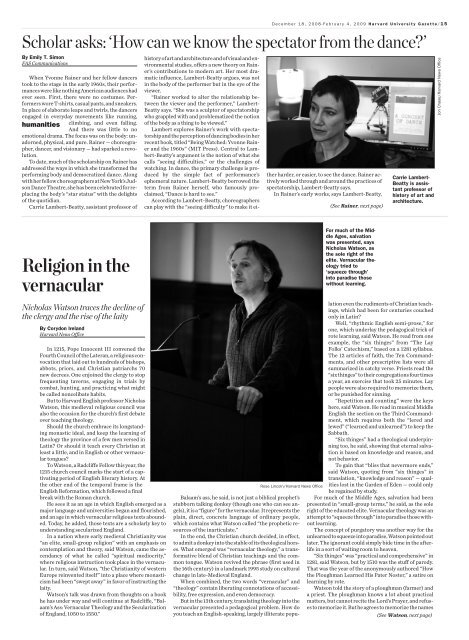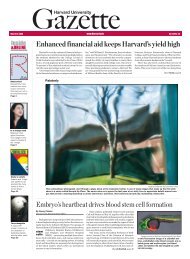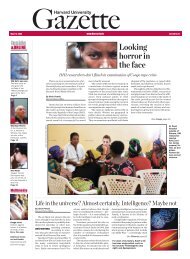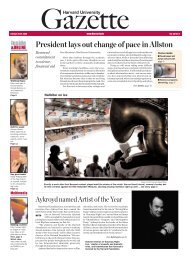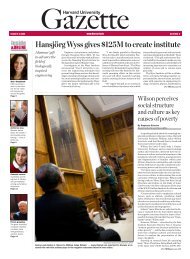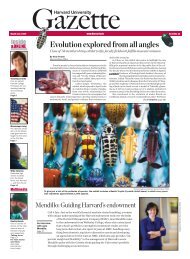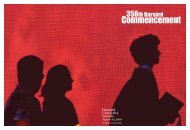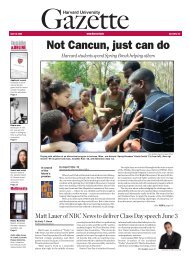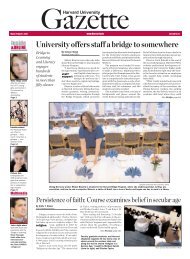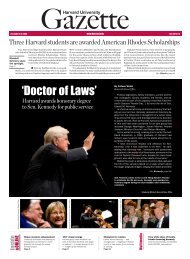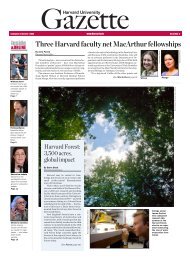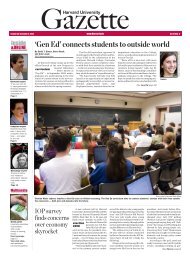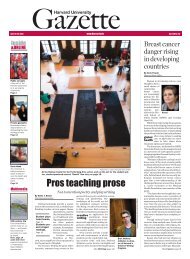14/ <strong>Harvard</strong> University Gazette December 18, 2008-February 4, 2009Government of India gives $4.5M to support grad studentsGift honors 75th birthdayof economist Amartya SenCivic(Continued from previous page)tion. Our lack of attention in general to coveringcivic and moral education issues certainlycontributes to the civic achievementgap, but it is much broader as well. Civic engagement,civic competencies, the skills andvalues that one needs to be an effective andempowered democratic citizen, really justaren’t on the table.”Both organizers cited as a positive stepthe recent election and influence and symbolismof the campaign of President-electBarack Obama, whose message, they said, ofengagement and inclusion resonated with awide audience.“I have to think that at least some peoplemay be more excited and interested becauseof Obama’s candidacy and election,” saidLevinson. “Both the way his political campaignwas run and the message that he hasbeen pretty consistent about sharing havecertainly brought civic engagement muchmore to the fore than has been true in thelast ten years.”The group’s first discussion was held inOctober and was led by HGSE visiting professorfrom the University of Bath HelenHaste, who explored a number of issues relatedto the field, including how civic andmoral education is impacted by the InternetPhotos Stephanie Mitchell/<strong>Harvard</strong> News OfficeAmartya Sen (from left), President Drew Faust, Ronen Sen, Indian ambassador to the United States, andSugata Bose gather to mark India’s gift to the University — and Amartya Sen’s birthday.The government of India has given<strong>Harvard</strong> University $4.5 million to supportfellowships for graduate studentsfrom India. The gift recognizes the accomplishmentsof <strong>Harvard</strong> Professor ofEconomics and Philosophy and ThomasW. Lamont University Professor AmartyaSen and his work for social and economicjustice across the globe. It also recognizesthe work of <strong>Harvard</strong>’s South Asia Initiativetoward establishing <strong>Harvard</strong> as a locus forthe study of South Asia.The gift will establish India Fellowships,which will provide fellowships tohighly accomplished and deserving studentsfrom India for studies at the GraduateSchool of Arts and Sciences.“<strong>Harvard</strong> is grateful to the governmentof India for this generous gift to supportgraduate students and to honor theimportant work of Professor AmartyaSen,” said <strong>Harvard</strong> University Presidentand Lincoln Professor of History DrewFaust. “We are fortunate to have Professor Sen onour faculty and share India’s pride in calling hima member of our community. I can think of nomore fitting way to celebrate Professor Sen and tostrengthen the important ties between <strong>Harvard</strong>and India.”“I am glad that <strong>Harvard</strong> has accepted this gifton the occasion of the 75th birth anniversary ofProfessor Amartya Sen, who is a great son of Indiaand one of the world’s foremost contemporarythinkers,” said Ronen Sen, ambassador of India tothe United States. “I am confident that these fellowships,by providing new opportunities for giftedstudents from India to study at <strong>Harvard</strong>, will furtherexpand the University’s impressive scholarshipon India, especially its South Asia Initiative.”Sen’s work in economics is celebrated for its interdisciplinarynature, with research in diverseareas such as development economics, philosophy,public health, and gender inequality. Althoughhe has spent his entire career in academia,Sen has translated his expertise in economics intopractical, on-the-ground approaches to predictand fight famine, as well as ways to measure poverty.In 1998, he won the Nobel Prize in economicsfor his contributions to the field of welfare economics.He has written extensively on economicjustice, and his books have been translated intoUniversity broadens engagementwith South Asia,www.news.harvard.edu/gazette/2007/11.01/03-southasia.htmlmore than 30 languages.“I am delighted that the gift will help bright Indianstudents to come to <strong>Harvard</strong>,” said Sen. “Thestudents receiving the India Fellowships will havethe opportunity of studying at what is perhaps thebest university in the world, and <strong>Harvard</strong> too willbenefit from having wonderful students whocould not otherwise afford to come here.”The South Asia Initiative at <strong>Harvard</strong> University,directed by Gardiner Professor of Oceanic Historyand Affairs Sugata Bose, is a center for scholarlyresearch and academic inquiry, with a particularfocus on modern India, Pakistan, andand the way people use new technologies tobuild civic communities and communicatetheir ideas. In November, Levinson, whotaught middle school students in Boston andAtlanta before coming to <strong>Harvard</strong>, offeredher perspective on African-American traditionsof civic education.In the most recent talk on Dec. 12, Selmanled a panel that questioned whetherstudents could learn about civic engagementby examining historical cases of attemptsto destroy it. In evaluating the programFacing History and Ourselves (FHAO),a professional development organizationfor educators, he told the crowd that he andhis colleagues reviewed its case-method approachto learning. The program uses historicalepochs and events, like the stepsleading up to the Holocaust, as a means ofguiding teachers in their conversations withtheir students about the kinds of messagesthey receive from society, or the times whenpeople find themselves in “we versus they”situations, and what, if anything, to do aboutthem.Examining the curriculum and even conductingsome of their own interviews withstudents, said Selman, helped him understandsome basic developmental questions.“We decided to use our research partnershipwith FHAO as a way to understandBangladesh. Sen is one of nine senior faculty memberswho compose the South Asia Initiative FacultySteering Committee, a cross-disciplinarybody that sets the academic agenda for the SouthAsia Initiative. Since its founding, the initiativehas convened renowned South Asia specialistsfrom around the globe, inviting scholars and publicleaders to <strong>Harvard</strong> as visiting academics andlecturers. Supporting international study programsfor both American and South Asian students,the initiative is highly regarded as a centerof excellence that reflects <strong>Harvard</strong>’s commitmentto international studies and expansion. In 2008,the initiative supported 67 students — 35 graduateand 32 undergraduate — with grants to studyand conduct research in South Asia.“Professor Amartya Sen has been an inspirationto generations of scholars and students. I canthink of no better way of honoring him on the occasionof his 75th birthday. The South Asia Initiativeis immensely grateful to the government andpeople of India for this farsighted gesture that willenhance the flow of knowledge between <strong>Harvard</strong>and India,” said Bose.“The students receivingthe IndiaFellowships willhave the opportunityof studyingat what isperhaps the bestuniversity in theworld, and <strong>Harvard</strong>too will benefitfrom havingwonderful studentswho couldnot otherwise affordto comehere.”Amartya Senhow kids thought about issues like inclusionand exclusion,” said Selman, who noted thatthe research suggested that “by high school,most students can understand that whenfaced with a we/they situation in school —like ostracism — they can take steps to improvethe school climate.”Yet, he also stressed, “it is important forstudents to be neither too idealistic nor toocynical in the strategies they can imaginechoosing. … Seeing connections and differencesto choices made by ordinary people inperiods when civil society is threatened iswhat a program like Facing History can helpteachers teach.”Levinson and Selman both note that thedefinition of civic education involves teachingstudents to appreciate how historicalconsciousness, ethical reflection, and civicparticipation may connect to one another.The basic tenets of participatory democracy,they agreed, are also essential.Also on the recent panel was HGSE graduateand current history teacher at CambridgeRindge & Latin School Joshua Landwher,who explained some of the strategieshe uses in teaching his students civicslessons from the past. Studying things likethe texts from the founding fathers, WorldWar I propaganda, or the Treaty of Versailles,he said, helps his students forge connectionsbetween history and civics.“I have [my class] try to work on formulatinga Versailles Treaty … an end to the war,a just peace or a victors’ peace,” Landwhersaid, adding that the students are exposedto the moral and ethical lessons of historyin part by putting themselves “back intothese places and [moments in time].”The CMEI colloquia series has beenheavily attended by students and facultyfrom HGSE and other <strong>Harvard</strong> Schools, aswell as by members of universities and organizationsin the Greater Boston area. Inaddition, students at HGSE have begun toorganize their own CMEI-affiliated group.As the series continues next year, organizershope to invite a representative fromthe Obama administration to talk about reshapingand reinvigorating civic engagementin a new political landscape. The groupalso hopes to create a cross-program concentrationin civic and moral education atHGSE.Perhaps the best indication of how importantthe topic has become arrived at lastweek’s discussion in the form of approximately20 young students from Landwher’shistory class. They scattered themselves onthe floor to listen to the presentation, choosingto, as their teacher put it, “participateand engage civically.”
By Emily T. SimonFAS CommunicationsWhen Yvonne Rainer and her fellow dancerstook to the stage in the early 1960s, their performanceswere like nothing American audiences hadever seen. First, there were no costumes. Performerswore T-shirts, casual pants, and sneakers.In place of elaborate leaps and twirls, the dancersengaged in everyday movements like running,climbing, and even falling.And there was little to noemotional drama. The focus was on the body: unadorned,physical, and pure. Rainer — choreographer,dancer, and visionary — had sparked a revolution.To date, much of the scholarship on Rainer hasaddressed the ways in which she transformed theperforming body and democratized dance. Alongwith her fellow choreographers at New York’s JudsonDance Theatre, she has been celebrated for replacingthe body’s “star status” with the delightsof the quotidian.Carrie Lambert-Beatty, assistant professor ofDecember 18, 2008-February 4, 2009 <strong>Harvard</strong> University Gazette/ 15Scholar asks: ‘How can we know the spectator from the dance?’humanitieshistory of art and architecture and of visual and environmentalstudies, offers a new theory on Rainer’scontributions to modern art. Her most dramaticinfluence, Lambert-Beatty argues, was notin the body of the performer but in the eye of theviewer.“Rainer worked to alter the relationship betweenthe viewer and the performer,” Lambert-Beatty says. “She was a sculptor of spectatorshipwho grappled with and problematized the notionof the body as a thing to be viewed.”Lambert explores Rainer’s work with spectatorshipand the perception of dancing bodies in herrecent book, titled “Being Watched: Yvonne Rainerand the 1960s” (MIT Press). Central to Lambert-Beatty’sargument is the notion of what shecalls “seeing difficulties,” or the challenges ofwatching. In dance, the primary challenge is producedby the simple fact of performance’sephemeral nature. Lambert-Beatty borrowed theterm from Rainer herself, who famously proclaimed,“Dance is hard to see.”According to Lambert-Beatty, choreographerscan play with the “seeing difficulty” to make it eitherharder, or easier, to see the dance. Rainer activelyworked through and around the practices ofspectatorship, Lambert-Beatty says.In Rainer’s early works, says Lambert-Beatty,(See Rainer, next page)Carrie Lambert-Beatty is assistantprofessor ofhistory of art andarchitecture.Jon Chase/<strong>Harvard</strong> News OfficeReligion in thevernacularNicholas Watson traces the decline ofthe clergy and the rise of the laityBy Corydon Ireland<strong>Harvard</strong> News OfficeIn 1215, Pope Innocent III convened theFourth Council of the Lateran, a religious convocationthat laid out to hundreds of bishops,abbots, priors, and Christian patriarchs 70new decrees. One enjoined the clergy to stopfrequenting taverns, engaging in trials bycombat, hunting, and practicing what mightbe called noncelibate habits.But to <strong>Harvard</strong> English professor NicholasWatson, this medieval religious council wasalso the occasion for the church’s first debateover teaching theology.Should the church embrace its longstandingmonastic ideal, and keep the learning oftheology the province of a few men versed inLatin? Or should it teach every Christian atleast a little, and in English or other vernaculartongues?To Watson, a Radcliffe Fellow this year, the1215 church council marks the start of a captivatingperiod of English literary history. Atthe other end of the temporal frame is theEnglish Reformation, which followed a finalbreak with the Roman church.He sees it as an age in which English emerged as amajor language and universities began and flourished,and an age in which vernacular religious texts abounded.Today, he added, those texts are a scholarly key tounderstanding secularized England.In a nation where early medieval Christianity was“an elite, small-group religion” with an emphasis oncontemplation and theory, said Watson, came the ascendancyof what he called “spiritual mediocrity,”where religious instruction took place in the vernacular.In turn, said Watson, “the Christianity of westernEurope reinvented itself” into a place where monasticismhad been “swept away” in favor of instructing thelaity.Watson’s talk was drawn from thoughts on a bookhe has under way and will continue at Radcliffe, “Balaam’sAss: Vernacular Theology and the Secularizationof England, 1050 to 1550.”Rose Lincoln/<strong>Harvard</strong> News OfficeFor much of the MiddleAges, salvationwas presented, saysNicholas Watson, asthe sole right of theelite. Vernacular theologytried to‘squeeze through’into paradise thosewithout learning.Balaam’s ass, he said, is not just a biblical prophet’sstubborn talking donkey (though one who can see angels),it is a “figure” for the vernacular. It represents theplain, direct, concrete language of ordinary people,which contains what Watson called “the prophetic resourcesof the inarticulate.”In the end, the Christian church decided, in effect,to admit a donkey into the stable of its theological horses.What emerged was “vernacular theology,” a transformativeblend of Christian teachings and the commontongue. Watson revived the phrase (first used inthe 16th century) in a landmark 1995 study on culturalchange in late-Medieval England.When combined, the <strong>two</strong> words “vernacular” and“theology” contain liberating connotations of accessibility,free expression, and even democracy.But in the 13th century, translating theology into thevernacular presented a pedagogical problem. How doyou teach an English-speaking, largely illiterate populationeven the rudiments of Christian teachings,which had been for centuries couchedonly in Latin?Well, “rhythmic English semi-prose,” forone, which underlay the pedagogical trick ofrote learning, said Watson. He read from oneexample, the “six thinges” from “The LayFolks’ Catechism,” based on a 1281 syllabus.The 12 articles of faith, the Ten Commandments,and other prescriptive lists were allsummarized in catchy verse. Priests read the“six thinges” to their congregations four timesa year, an exercise that took 25 minutes. Laypeople were also required to memorize them,or be punished for sinning.“Repetition and counting” were the keyshere, said Watson. He read in musical MiddleEnglish the section on the Third Commandment,which requires both the “lered andlewed” (“learned and unlearned”) to keep theSabbath.“Six thinges” had a theological underpinningtoo, he said, showing that eternal salvationis based on knowledge and reason, andnot behavior.To gain that “bliss that nevermore ends,”said Watson, quoting from “six thinges” intranslation, “knowledge and reason” — qualitieslost in the Garden of Eden — could onlybe regained by study.For much of the Middle Ages, salvation had beenpresented in “small-group terms,” he said, as the soleright of the educated elite. Vernacular theology was anattempt to “squeeze through” into paradise those withoutlearning.The concept of purgatory was another way for theunlearned to squeeze into paradise, Watson pointed outlater. The ignorant could simply bide time in the afterlifein a sort of waiting room to heaven.“Six thinges” was “practical and comprehensive” in1281, said Watson, but by 1510 was the stuff of parody.That was the year of the anonymously authored “Howthe Ploughman Learned His Pater Noster,” a satire onlearning by rote.Watson told the story of a ploughman (farmer) anda priest. The ploughman knows a lot about practicalmatters, but cannot recite the Lord’s Prayer, and refusesto memorize it. But he agrees to memorize the names(See Watson, next page)
- Page 1 and 2: 36/ Harvard University Gazette Dece
- Page 3 and 4: December 18, 2008-February 4, 2009
- Page 5 and 6: December 18, 2008-February 4, 2009
- Page 7 and 8: December 18, 2008-February 4, 2009
- Page 9 and 10: By Holly MetterFAS CommunicationsTh
- Page 11 and 12: December 18, 2008-February 4, 2009
- Page 13: Fair shows progress of humanities i
- Page 17: 60HarvardcelebratesThe UniversalDec
- Page 20 and 21: December 18, 2008-February 4, 2009
- Page 22 and 23: Upon the recommendation of the dean
- Page 24 and 25: December 18, 2008-February 4, 2009
- Page 26 and 27: December 18, 2008-February 4, 2009
- Page 28 and 29: December 18, 2008-February 4, 2009
- Page 30 and 31: December 18, 2008-February 4, 2009
- Page 32 and 33: December 18, 2008-February 4, 2009
- Page 34: Antarctica(Continued from page 1)Su


